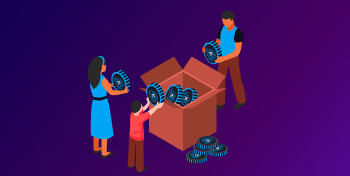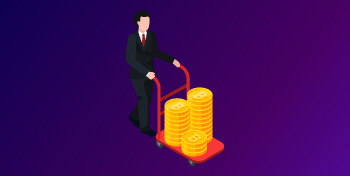Bitcoin is a community that according to Coinmarketrate.com, originates from 2009. We are talking about decentralization and the transfer of power and control into the hands of people. It creates an independent network in which users themselves are responsible for the operation and management of the ecosystem. To achieve this, Bitcoin creator Satoshi Nakamoto introduced the concept of nodes and miners.
Crypto technologies may be difficult to understand but it’s worth knowing exactly how the blockchain works, and in what less obvious ways it can benefit you. Let’s talk about this.
Currently, we mainly use our bank accounts for financial transactions. So, what are banks really doing? They perform three main functions.
- They help us keep our money
- They provide the infrastructure for conducting transactions
- They keep records of all these transactions, and update data on various accounts.
However, the problem with banks is that they are centralized. Therefore, when we store our money in banks, we actually trust this system with full control over our finances. Although we can still make transactions, the rules are determined by the banks, and we have neither ultimate control nor ownership of our own assets.
In addition, poor governance, security problems, downtime and corruption make the centralized banking system even more disappointing. A little more than a decade ago, the world faced a financial crisis because banks did not regulate how they invest customer funds, and continued to function only in order to make a big profit. This, combined with several other factors, led to a crisis, as a result of which millions of people lost their jobs and savings.
It is for this reason that Satoshi Nakamoto has developed a Bitcoin blockchain network that works as a peer-to-peer network for payments. His idea was to offer people a financial system that could do everything that banks did for us, but without having to trust the central authority. A system without trust.
And Bitcoin has really achieved this goal. It is a secure, immutable and transparent registry that helps you store funds and conduct transactions with anyone around the world.
You are probably wondering: who manages the system if there is no bank?
Instead of a central authority that verifies and registers transactions, Bitcoin has a network of computers called nodes and miners. When you initiate a Bitcoin transaction, its details are distributed through this network working in unison to make sure that you really own the funds you are trying to spend.
Below we will look at what nodes and miners are and how everything works.
Don’t confuse miners with nodes
Very often the words “nodes” and “miners” are used interchangeably. So let’s deal with this first.
- The concept of Nodes
A node in the Bitcoin network is any computer on which Bitcoin Core is constantly running – software that allows computers to download and store the entire Bitcoin blockchain, as well as check and record new transactions as they occur. Since there are no central structures, it is these thousands of nodes that always verify each new transaction with existing records and filter out transactions that may try to cheat the system or break the rules. A larger number of nodes means that records are stored on more systems, which means it becomes more difficult to deceive the entire system.
- Understanding what miners are
On the other hand, a miner is a special computer system that uses high-performance computing equipment to add new sets (blocks) of transactions to the blockchain, and generate new BTC with each block. But in order to add new transactions, you first need to know which transactions are being requested, so each miner must first be a node that can accept and write new transactions.
But, each node does not have to be a miner. Anyone can run a node with simple hardware to secure the Bitcoin network and record all transactions in real time.
Confused? You shouldn`t For a better understanding, we will analyze the Bitcoin transaction and see how it works.
Petya, Vasya, nodes and miners
Nodes start working
For example, Petya wants to send 1 BTC to Vasya. When Petya enters the amount and address of Vasya’s Bitcoin wallet and confirms the transaction from his wallet, the transaction details are sent to several of the thousands of Bitcoin nodes. The first few nodes that received the transaction verify it with the records they have and check whether there is 1 BTC in Petya’s wallet that he is trying to send. If everything is in order, the first nodes transmit the transaction to other nodes, which then verify it and pass it on. This continues until all nodes receive transaction data.
After verifying the details of Petya`s transaction, it is sent to the memory pool, where many other BTC transactions from other Bitcoin users are waiting for confirmation and addition to the existing blockchain.
Miners take Responsibility
This is where the BTC miners come into play. The job of these miners is to take pending transactions from Petya and other Bitcoin users, assemble them into a block and add them to the Bitcoin blockchain. How do they do it?
Imagine Bitcoin mining as an extremely difficult puzzle solving competition where a person is given an almost solved puzzle with a few missing pieces. Now the missing pieces are mixed with thousands of other random pieces. And the one who finds the necessary fragment first and completes the puzzle leaves with a prize. There is no algorithm here that you could use. It’s just a game of luck in which you can use trial and error. And the faster you try random pieces and cross out the wrong ones, the higher your chances of finding the right piece.
In Bitcoin mining, this is exactly what miners do. They have all the transaction details they need to add to the new block, and they can generate a unique block identifier called a “hash” by passing the details through the encryption technique used in Bitcoin. However, in order to add these transactions to the blockchain and receive a reward from Bitcoin for this, the miner must first find one missing piece of the puzzle, which is called nonce.
A nonce is a random number, similar to a missing piece of a puzzle, mixed with many other random fragments. Miners need it so that they can attach it to the hash of their block, pass it through the encryption algorithm again, so that the result is a hash that Bitcoin recognizes as the solution to the puzzle.
It may take millions of attempts to find this prime number. And, as you can guess, it is beyond the power of man. Therefore, miners use powerful computing devices to run thousands of numbers every second and generate new hashes, and check if they can find a solution. And the miner with more computing power obviously has a better chance of finding this number.
- Back to the nodes
A miner who has found the right solution for a block with the Petya`s transaction, first submits it for approval to the entire network of nodes.
Now the final check is in the hands of the nodes. They check the solution and make sure that all transactions included in this block are fair and comply with the rules of the network. If everything is confirmed by the majority of Bitcoin nodes, they agree to add a new block to the existing blockchain, and thus the data of the Petit transaction, together with the data of others included in this block, are irreversibly confirmed and recorded.
The miner who first found the solution goes home with a freshly generated Bitcoin, which currently costs 6.25 BTC per block. And the process repeats over and over again.
Why run only node
Unlike miners, participants who manage only nodes do not receive any remuneration. Their job is simply to maintain the latest transaction record. But then why would someone manage a node if it doesn’t bring any financial benefit?
Because sometimes there’s more to it than just money. You can start a node to
- Contribute to the security of the Bitcoin network.
Bitcoin is decentralization. Therefore, when you start a node, you increase the number of BTC nodes, thereby making the network more decentralized and secure. Nodes also ensure that users and miners play by the rules of the network.
Also, this provides you with real privacy from any third-party wallet provider. When you start a node, you first need a wallet created directly on the Bitcoin network without any service provider. It is stored in your system and thus provides you with complete confidentiality.
- Have full autonomy
People use Bitcoin to avoid trusting third parties. But this logic immediately disappears when you use a third-party website to verify Bitcoin transactions. Who knows if their system is working correctly or not? In this case, node management makes you your own source of truth, allowing you to independently verify all transactions in the Bitcoin blockchain.
- Get the Opportunity to Participate in Bitcoin Management
Changes to the Bitcoin network can only be made with the consent of the majority of network nodes. Thus, if you manage a node, you have a say in updating the network, like, for example, a recently implemented update called Taproot. In order for this update to be implemented, the nodes had to signal their support for the network, and reach a consensus on this issue.
Even in the event of a chain split due to disagreements between network members, you can choose which chain you want to support only if you have a full node running. This was observed in 2017 during the Bitcoin upgrade called SegWit, when the Bitcoin chain was split due to disagreements between nodes, and Bitcoin Cash was created.
- Affordable
Unlike mining, the node does not require computing equipment or installations. You can run a full node on most basic computers, which are equipped with only 350 GB, 2 GB of RAM and unlimited Internet connection.
Summing up
Bitcoin is a financial revolution. It creates a more reliable system by directly distributing responsibility for its functioning among its own users. There are no central structures in this financial system, there are practically no opportunities for corruption, and the probability of network failure is close to zero.
All there is is freedom and decentralization. Everyone who uses Bitcoin feels this freedom. But more than that, everyone has a fair chance to make this network more decentralized and secure. Therefore, if you want to feel both freedom and the role that you can play in ensuring the security of Bitcoin, it is worth creating your own node.


